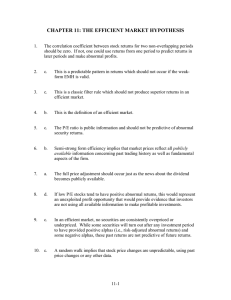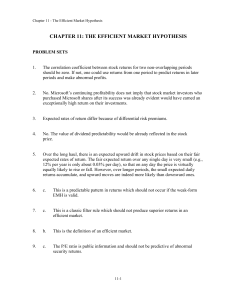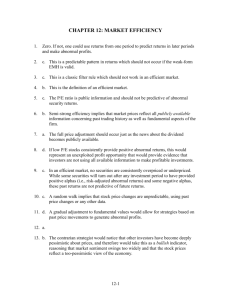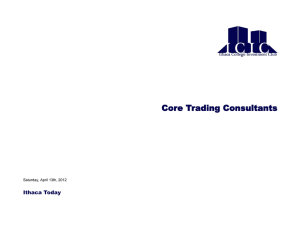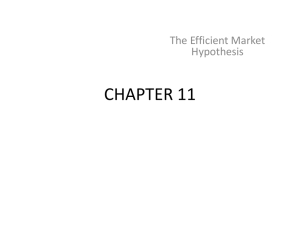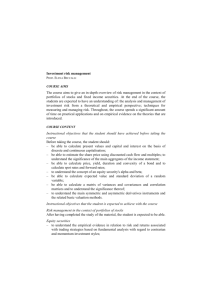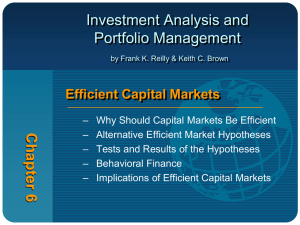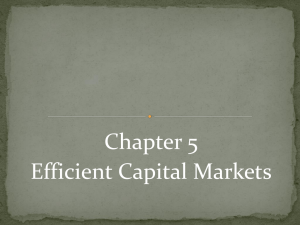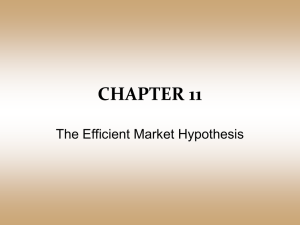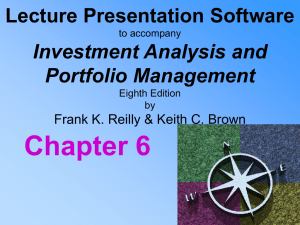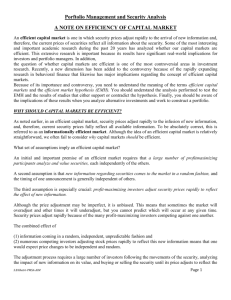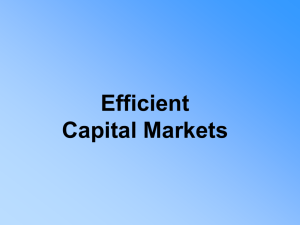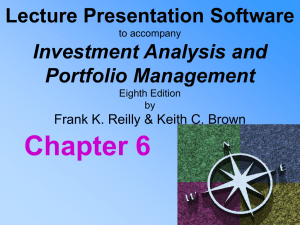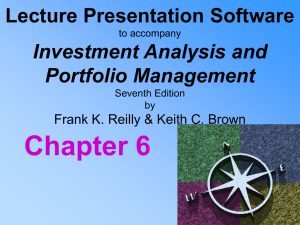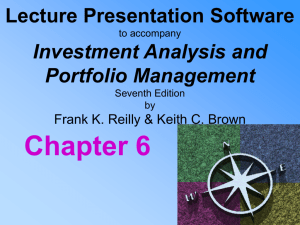SM_C05_Reilly1ce
advertisement
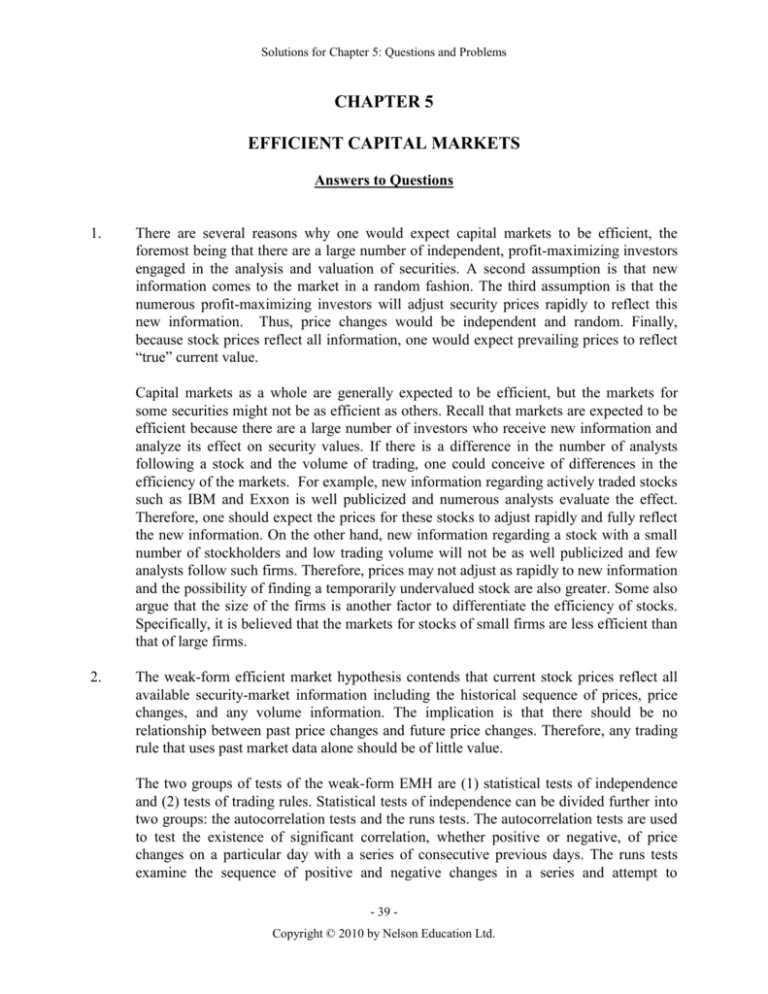
Solutions for Chapter 5: Questions and Problems CHAPTER 5 EFFICIENT CAPITAL MARKETS Answers to Questions 1. There are several reasons why one would expect capital markets to be efficient, the foremost being that there are a large number of independent, profit-maximizing investors engaged in the analysis and valuation of securities. A second assumption is that new information comes to the market in a random fashion. The third assumption is that the numerous profit-maximizing investors will adjust security prices rapidly to reflect this new information. Thus, price changes would be independent and random. Finally, because stock prices reflect all information, one would expect prevailing prices to reflect “true” current value. Capital markets as a whole are generally expected to be efficient, but the markets for some securities might not be as efficient as others. Recall that markets are expected to be efficient because there are a large number of investors who receive new information and analyze its effect on security values. If there is a difference in the number of analysts following a stock and the volume of trading, one could conceive of differences in the efficiency of the markets. For example, new information regarding actively traded stocks such as IBM and Exxon is well publicized and numerous analysts evaluate the effect. Therefore, one should expect the prices for these stocks to adjust rapidly and fully reflect the new information. On the other hand, new information regarding a stock with a small number of stockholders and low trading volume will not be as well publicized and few analysts follow such firms. Therefore, prices may not adjust as rapidly to new information and the possibility of finding a temporarily undervalued stock are also greater. Some also argue that the size of the firms is another factor to differentiate the efficiency of stocks. Specifically, it is believed that the markets for stocks of small firms are less efficient than that of large firms. 2. The weak-form efficient market hypothesis contends that current stock prices reflect all available security-market information including the historical sequence of prices, price changes, and any volume information. The implication is that there should be no relationship between past price changes and future price changes. Therefore, any trading rule that uses past market data alone should be of little value. The two groups of tests of the weak-form EMH are (1) statistical tests of independence and (2) tests of trading rules. Statistical tests of independence can be divided further into two groups: the autocorrelation tests and the runs tests. The autocorrelation tests are used to test the existence of significant correlation, whether positive or negative, of price changes on a particular day with a series of consecutive previous days. The runs tests examine the sequence of positive and negative changes in a series and attempt to - 39 Copyright © 2010 by Nelson Education Ltd. Solutions for Chapter 5: Questions and Problems determine the existence of a pattern. For a random series one would expect 1/3(2n - 1) runs, where n is the number of observations. If there are too few runs (i.e., long sequences of positive changes or long sequences of negative changes), the series is not random, i.e., you would not expect a positive change to consistently follow a positive change and a negative change consistently after a negative change. Alternatively, if there are too many runs (+-+-+-+- etc.), again the series is not random since you would not expect a negative change to consistently follow a positive change. In the trading rule studies, the second major set of tests, investigators attempted to examine alternative technical trading rules through simulation. The trading rule studies compared the risk-return results derived from the simulations, including transaction costs, to results obtained from a simple buy-and-hold policy. 3. The semistrong-form efficient market hypothesis contends that security prices adjust rapidly to the release of all new public information and that stock prices reflect all public information. The semistrong-form goes beyond the weak-form because it includes all market and also all nonmarket public information such as stock splits, economic news, political news, etc. Using the organization developed by Fama, studies of the semistrong-form EMH can be divided into two groups: (1) Studies that attempt to predict futures rates of return using publicly available information (goes beyond weak-form EMH). These studies involve either time-series analysis of returns or the cross-section distribution of returns. (2) Event studies that examine abnormal rates of return surrounding specific event or item of public information. These studies determine whether it is possible to make average risk-adjusted profits by acting after the information is made public. 4. Abnormal rate of return is the amount by which a security’s return differs from the expected rate of return based upon the market’s rate of return and the security’s relationship with the market. 5. The CAPM is grounded in the theory that investors demand higher returns for higher risks. As a result of risks specific to each individual security, the announcement of a significant economic event will tend to affect individual stock prices to a greater or lesser extent than the market as a whole. Fama, Fisher, Jensen, and Roll portrayed this unique relationship of stock returns and market return for a period prior to and subsequent to a significant economic event as follows: Rit = ai + Bi Rmt + e where Rit = the rate of return on security i during period t ai = the intercept or constant for security in the regression Bi = the regression slope coefficient for security i equal to covim/m2 Rmt = the rate of return on a market index during period t e = a random error that sums to zero - 40 Copyright © 2010 by Nelson Education Ltd. Solutions for Chapter 5: Questions and Problems As an example of how one would derive abnormal risk-adjusted returns for a stock during a specific period, assume the following values for a firm: ai = .01 and Bi = 1.40 If the market return (Rmt) during the specified period were 8%, the expected return for stock i would be: E(Rit) = = = .01 + 1.4(.08) .01 + .112 .122 The fact that this is the expected value implies that the actual value will tend to deviate around the expected value. We will define the abnormal return (ARit) as the actual return minus the expected return. In our example, if the actual return for the stock during this period were 10%, the abnormal return for the stock during the period would be ARit = .10 - .122 = -.022 Thus, the stock price reacted to the economic event in a manner that was 2.2% less than expected where expectations were based upon what the aggregate market did and the stock’s relationship with the market. This abnormal return surrounding an economic event can be used to determine the effect of the event on the individual security. 6. First, only use information or data that is publicly available at the time of the decision. As an example, if you use information that is typically not available until six weeks after a period and you assume you have it four weeks after, your investment results should be superior because you implicitly have prior information. Second, account for all transactions costs for the trading rule. This is important because almost all trading rules involve more transactions than a buy-and-hold policy and if you don’t consider this, it will bias the results against buy-and-hold. Third, be sure to adjust all results for the risk involved because many trading rules will tend to select high-risk stocks that will have higher returns. 7. A number of studies have examined the adjustment of stock prices to major world events. These studies analyzed the effect of several unexpected world events on stock prices namely, whether prices adjusted before or during the announcement or after it. The results consistently showed that the adjustments took place between the close of the previous day and the opening of the subsequent day. Notably, an investor could not derive above average profits from transacting after the news became public, thus supporting the semistrong-form EMH. - 41 Copyright © 2010 by Nelson Education Ltd. Solutions for Chapter 5: Questions and Problems 8. In the early 1970s, several studies were performed that examined quarterly earnings reports. The results of the studies provided evidence against the semistrong-form EMH. Specifically, buying a stock after a report of unexpected higher quarterly earnings was profitable. Generally, the abnormal return for the stock occurred 13 or 26 weeks following the earnings announcement and reflected the size of the unanticipated earnings change. 9. Studies on market efficiency are considered to be dual tests of the EMH and the CAPM. These tests involve a joint hypothesis because they consider not only the efficiency of the market, but also are dependent on the asset pricing model that provides the measure of risk used in the test. For example, if a test determines that it is possible to predict future differential risk-adjusted returns, the results could either have been caused by the market being inefficient or because the risk measure is bad thereby providing an incorrect riskadjusted return. 10. The strong-form efficient market hypothesis asserts that stock prices fully reflect all information, whether public or private. It goes beyond the semistrong-form because it requires that no group of investors have a monopolistic access to any information. Thus, the strong-form efficient market hypothesis calls for perfect markets in which all information is available to everyone at the same time. 11. The strong-form efficient market hypothesis goes beyond the semistrong-form in that it calls for perfect markets - i.e., no group of investors has a monopolistic access to information. Thus, tests for the strong-form efficient market hypothesis would center around examining whether any group has a monopolistic access to information and can consistently obtain above average profits by using it. Four groups of investors have been featured in these tests -corporate insiders, the stock exchange specialist, security analysts and professional money managers. 12. In the early 1970s, a study by the SEC found that by having access to the limit order books as his source of monopolistic information, coupled with low transaction costs, the stock market specialist consistently obtained above average returns. This is evidence against the strong-form hypothesis because this group apparently has a monopoly source of information and uses it to derive above normal returns. 13. Studies by several authors examined the risk-adjusted performance of professional money managers for various periods and found support for the strong-form efficient market hypothesis. For example, a historical study of mutual fund money managers found that on a risk-adjusted basis net of commissions, only about one-third of the funds outperformed the market. More recent studies have also generally provided similar results on performance. - 42 Copyright © 2010 by Nelson Education Ltd. Solutions for Chapter 5: Questions and Problems 14. Behavioural finance deals with individual investor psychology and how it affects individuals’ actions as investors, analysts, and portfolio managers. The goal of behavioural finance is to understand how psychological decisions affect markets and to be able to predict those effects. Behavioural finance looks to explain anomalies that can arise in markets due to psychological factors. 15. The proponents of behavioural finance contend that, although standard finance theory is acceptable in that it focuses on aggregate market behaviour, it is incomplete because it fails to account for individual behaviour. 16. The basic premise of technical analysis is that the information dissemination process is slow-thus the adjustment of prices is not immediate but forms a pattern. This view is diametrically opposed to the concept of efficient capital markets, which contends that there is a rapid dissemination process and, therefore, prices reflect all information. Thus, there would be no value to technical analysis because technicians act after the news is made public which would negate its value in an efficient market. 17. The proponents of fundamental analysis advocate that at one point in time there is a basic intrinsic value for the aggregate stock market, alternative industries, and individual securities and if this intrinsic value is substantially different from the prevailing market value, the investor should make the appropriate investment decision. In the context of the efficient market hypothesis, however, if the determination of the basic intrinsic value is based solely on historical data, it will be of little value in providing above average returns. Alternatively, if the fundamental analyst makes superior projections of the relevant variables influencing stock prices then, in accordance with the efficient market hypothesis, he could expect to outperform the market. The implication is that even with an excellent valuation model, if you rely solely on past data, you cannot expect to do better than a buy-and-hold policy. 18. To be superior in an efficient market the analyst must be aware of the relevant variables influencing stock prices, and be able to consistently project these accurately. If the analyst does not have access to inside information and lacks superior analytical ability, there is little likelihood of obtaining above average returns consistently. To establish the superiority of an analyst it is appropriate to examine the performance of numerous buy and sell recommendations by the analyst over a period of time relative to a randomly selected sample of stocks in the same risk class. To be superior the analyst must consistently perform better than the random selection. Consistency is emphasized because on average you would expect random selection to outperform the market about half the time. - 43 Copyright © 2010 by Nelson Education Ltd. Solutions for Chapter 5: Questions and Problems 19. Superior analysts should concentrate their efforts in the second tier of stocks, because they do not receive the attention given the top-tier stocks. Also these analysts should pay attention to BV/MV ratios and the size of the firms. Analysts should concentrate their efforts on these securities, since they are more likely to yield abnormal returns. 20. The major efforts of the portfolio manager should be directed toward determining the risk preferences of his clients and offering, accordingly, a portfolio approximating the risk and return desires of the clientele. Given evidence of the stationarity of beta for a portfolio, this would not be a difficult task. Further, the level of risk can be controlled by committing a portion of the portfolio to a risk free asset and changing this proportion from time to time in accordance with the client’s risk preferences. Second, the portfolio manager should attempt to achieve complete diversification eliminate all unsystematic risk. Thus, the portfolio should be highly correlated with the market portfolio of risky assets. Finally, it is important to minimize transactions costs - minimize taxes for the client, minimize commissions by reducing trading turnover, and minimizing liquidity costs by only trading currently liquid stocks. 21. Index funds are security portfolios specially designed to duplicate the performance of the overall security market as represented by some selected market index series. The first group of index funds was created in the early 1970s because people started realizing that capital markets are efficient and it is extremely difficult to be a superior analyst. Thus, instead of trying to outperform the market, a large amount of money should be managed “passively” so that the investment performance simply matches that achieved by the aggregate market and costs are minimized so as not to drop returns below the market. An abundance of research has revealed that the performance of professional money managers is not superior to the market, and often has been inferior. This is precisely what one would expect in an efficient capital market. Thus, rather than expending a lot of effort in selecting a portfolio, the performance of which may turn out to be inferior to the market, it is contended by some that portfolios should be designed to simply match the market. If you match the market and minimize transactions costs you will beat two-thirds of the institutional portfolio managers on average. The index funds are intended to match the market and minimize costs as suggested above. Thus, they are consistent with the EMH. - 44 Copyright © 2010 by Nelson Education Ltd. Solutions for Chapter 5: Questions and Problems 22. The portfolio manager should continue to allow his two superior analysts to make investment recommendations for some proportion of the portfolio, making sure that their recommendations are implemented in a way that would conform to the mutual funds states risk profile. They should also be encouraged to concentrate their efforts in the second tier of stocks, because the second tier is probably not as efficient as the top tier (because of lower trading volume) and the possibility of finding a temporarily undervalued security are greater. On the other hand, the portfolio manager should encourage the average and inferior analysts to direct their efforts to matching the performance of the aggregate market. As a result, the overall performance of the portfolio should be superior to the average market performance. - 45 Copyright © 2010 by Nelson Education Ltd. Solutions for Chapter 5: Questions and Problems CHAPTER 5 Answers to Problems 1. ARit = Rit - Rmt ARBt = 11.5 - 4.0 = 7.5 ARFt = 10.0 - 8.5 = 1.5 ARTt = 14.0 - 9.6 = 4.4 ARCt = 12.0 - 15.3 = - 3.3 2. AREt = 15.9 - 12.4 = 3.5 ARit = Rit - (beta) (Rmt) ARBt = 11.5 - .95(4.0) = 7.7 ARFt = 10.0 - 1.25(8.5) = -.625 ARTt = 14.0 - 1.45(9.6) = .08 ARCt = 12.0 - .70(15.3) = 1.29 AREt 3. = 15.9 - (-.3)(12.4) = 19.62 The reason for the difference in each case is due to the implications of beta. Beta determines how the stock will move in relation to movements in the market. Considering stock C, a 1% change in the market return will result in a 0.70% change in stock C’s return. Therefore, comparing the abnormal return for stock C, the value becomes positive in Problem 2. Conversely, the 1.25% change expected by stock F, for every 1% change in the market, resulted in the abnormal return moving from positive to negative. Stock E should move opposite the market because of the negative beta value. Thus, stock E has a very large abnormal return. For stocks B and T, the positive abnormal returns remain positive but do change in value. 4. Student Exercise - 46 Copyright © 2010 by Nelson Education Ltd.
